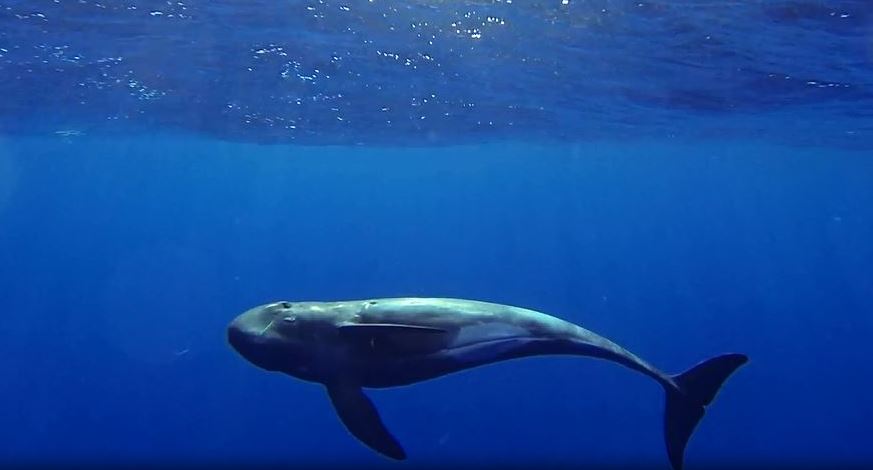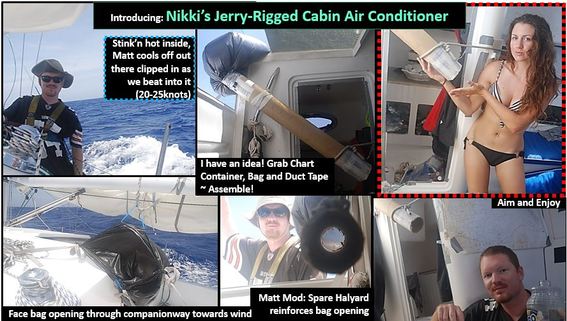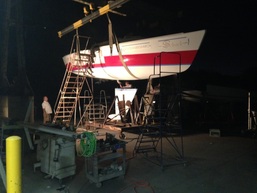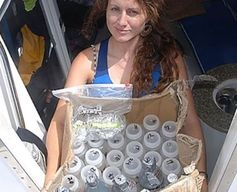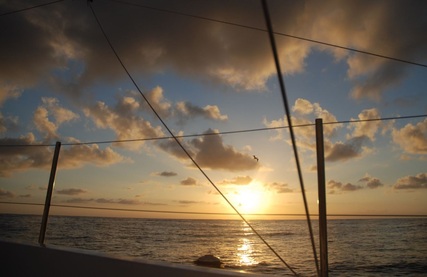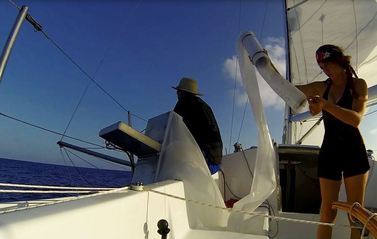 Gathering marine plastic pollution data. (Photos courtesy of ORP)
Gathering marine plastic pollution data. (Photos courtesy of ORP)
Matt Rutherford and Nicole Treholm just spent 63 days sailing across the Pacific Ocean in a prototype WD Schock 29 called the Sakura.
During the 6,500-mile voyage from California to Japan, they had to jerry-rig a compression post when the deck cracked above and below the mast; they almost caught a shark in their research net; and they gathered new data on marine plastic pollution.
It’s all in a day’s work for these ocean veterans.
Rutherford, Founder and Executive Director of the nonprofit Ocean Research Project, made the first nonstop solo voyage around North and South America, spending 309 days at sea from June 2011 to April 2012 and earning two Guinness World Records. Trenholm, ORP’s Program Director and Field Operations Scientist, is a 100 ton US Coast Guard Nearshore licensed Captain, and a former hydrographer and mate for NOAA.
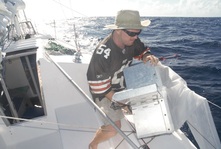 Rutherford collects data for ORP
Rutherford collects data for ORP
Through ORP, some of their data is submitted to partnering institutions, some is analyzed in-house, and most are available as an open source upon request.
As well, they collected microplastics samples for our microplastics project.
“We knew a gale was coming, and in theory we had just enough time to make it to land, so we went for it,” Rutherford wrote on their blog on July 2. “We pushed the boat as hard as possible and made it to the entrance of Yokohama, very happy to be across.”
Q&A with the Ocean Research Project Crew
ASC: 63 days at sea is a long time! What skills did you need most out there?
Rutherford: I can teach anyone how to sail across an ocean, but I can’t teach anyone the mentality necessary to do it. You need to be disciplined more than you need skills to be able to spend all that time on a little boat.
Rutherford: When the wind dies down, Nikki likes to go dumpster diving in the gyre. She stands in the cockpit with our large fishing net, pointing out plastic flotsam that looks interesting. We sail over, she scoops it up and investigates and photographs the debris.
A few days ago, she scooped up a large piece of plastic, which looked like part of a car fender, and accidentally caught a good sized fish. I have heard of people catching fish in strange ways, but I’ve never seen someone catch a 10-pound fish completely on accident without a fishing pole.
ASC: Most challenging part?
Rutherford: The greatest challenge was just to get off the dock in California. We arrived and had to build our boat in lest than 24 days! We debuted the boat at the Strictly Sailing Pacific Boat Show half completed.
Trenholm: It was not a problem. We were already sailing across the wide open ocean. It only makes sense to collect as much data (samples) for as many programs when you have the opportunity too be in the ocean wilderness.
ASC: Any cool animal sightings?
Rutherford: Six days ago we were pulling our net collecting a microplastics sample like we have many times before. I was sitting in the cockpit staring out to sea in a mindless trance, when all of a sudden, SHARK! An 8-10 foot white tip shark was swimming straight for our Avani net, which [we were pulling] through the water.
The shark came right up to the tail end of the net, mouth wide open, just a few feet from the boat. I’m yelling and waving my arms, knowing the shark isn’t paying any attention to me. Just then the shark closes its mouth, rams the mesh net, sits there and disappears. It must have realized the net wasn’t food at the last second.
For a moment I thought our net would be destroyed, and our research would be over.

